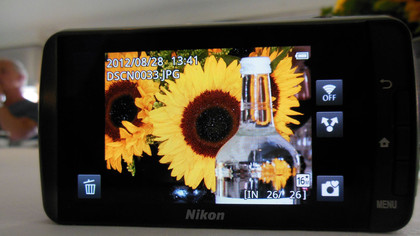Why you can trust TechRadar
Images from the Nikon S800c are pleasing, with a good amount of detail, accurate colour renditions and lots of vibrancy.
In good lighting conditions, the images seem slightly better than those from a highly specced smartphone, but it's in lower light conditions that the Nikon Coolpix S800c, with its larger sensor, does a better job than the average phone.

Overall, images appear sharp, but examining them at 100% does reveal some element of image smoothing. At normal printing and web sizes this isn't an issue, though.
Having a 10x optical zoom in the small body of the Nikon S800c is what elevates it above the status of the smartphone, with images taken at the furthest reach of the telephoto optic showing a high level of quality.

The Nikon S800c is also equipped with a digital zoom. Although the quality of images shot with this deployed is noticeably worse, it's nevertheless handy to have for hard to reach subjects. It also seems to be better than the digital zooms found on most smartphones, which is another bonus.
Autofocus acquisition, in the majority of cases, is quick and accurate, dropping slightly in lower light conditions. There is the option to switch on macro focusing for close-up shots, which means you can shoot from pretty close quarters, and that it's also relatively quick and accurate.

Having the ability to set autofocus points via the touchscreen is useful, and certainly speeds up the process.
Sign up for breaking news, reviews, opinion, top tech deals, and more.
There's not much in the way of manual control on the Nikon S800c. Matrix (sometimes known as evaluative) metering is used all the time, for instance. Generally it does a reasonable job of assessing the scene, though it can struggle a little in mixed or direct lighting conditions.

You can alter the white balance mode, from auto to the usual range, which includes daylight, incandescent, cloudy and so on, as well as a manual preset. Auto white balance does a decent job overall of assessing the lighting to provide accurate colours.
Sensitivity can be pushed to ISO 3200, while there's also the option to shoot in Auto with a maximum cap of ISO 400, which is useful if you want to avoid image noise. At high sensitivities, noise is generally controlled reasonably well, with images useable at small sizes at the higher end of the scale.

Shooting modes are fairly minimal, with the choice between Easy Auto mode (restricted settings), Auto mode and Scene modes. For those who just want to snap, it's easiest to use Easy Auto mode.
Many compact cameras include digital filters for those looking to get a little bit more creative with their images. There's a scant few to choose from on the Nikon S800c, but since there's a huge variety of apps to download, this isn't really something to worry about.

Because it's a capacitive touchscreen (like you find on an iPhone), it's pretty responsive and easy to use. One small complaint is that using the onscreen keyboard for certain apps (such as Facebook or Instagram) can be a little fiddly, since it's so small.
The screen is also pretty bright, and viewable from quite a few different angles, which is useful when you want to shoot from above, or low down. In all but the brightest of conditions, glare is kept to a minimum, keeping the touchscreen it useable in most situations.

Amy has been writing about cameras, photography and associated tech since 2009. Amy was once part of the photography testing team for Future Publishing working across TechRadar, Digital Camera, PhotoPlus, N Photo and Photography Week. For her photography, she has won awards and has been exhibited. She often partakes in unusual projects - including one intense year where she used a different camera every single day. Amy is currently the Features Editor at Amateur Photographer magazine, and in her increasingly little spare time works across a number of high-profile publications including Wired, Stuff, Digital Camera World, Expert Reviews, and just a little off-tangent, PetsRadar.
